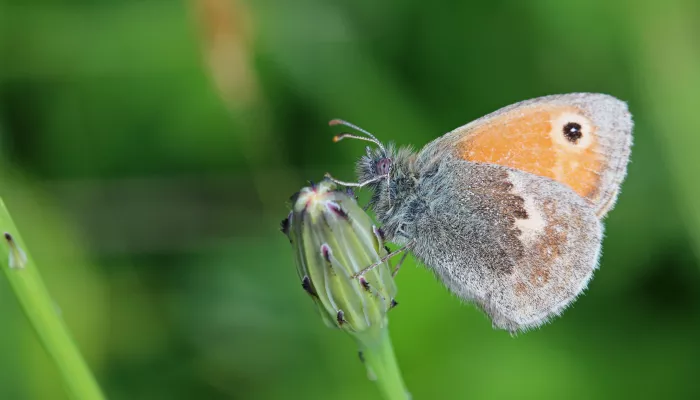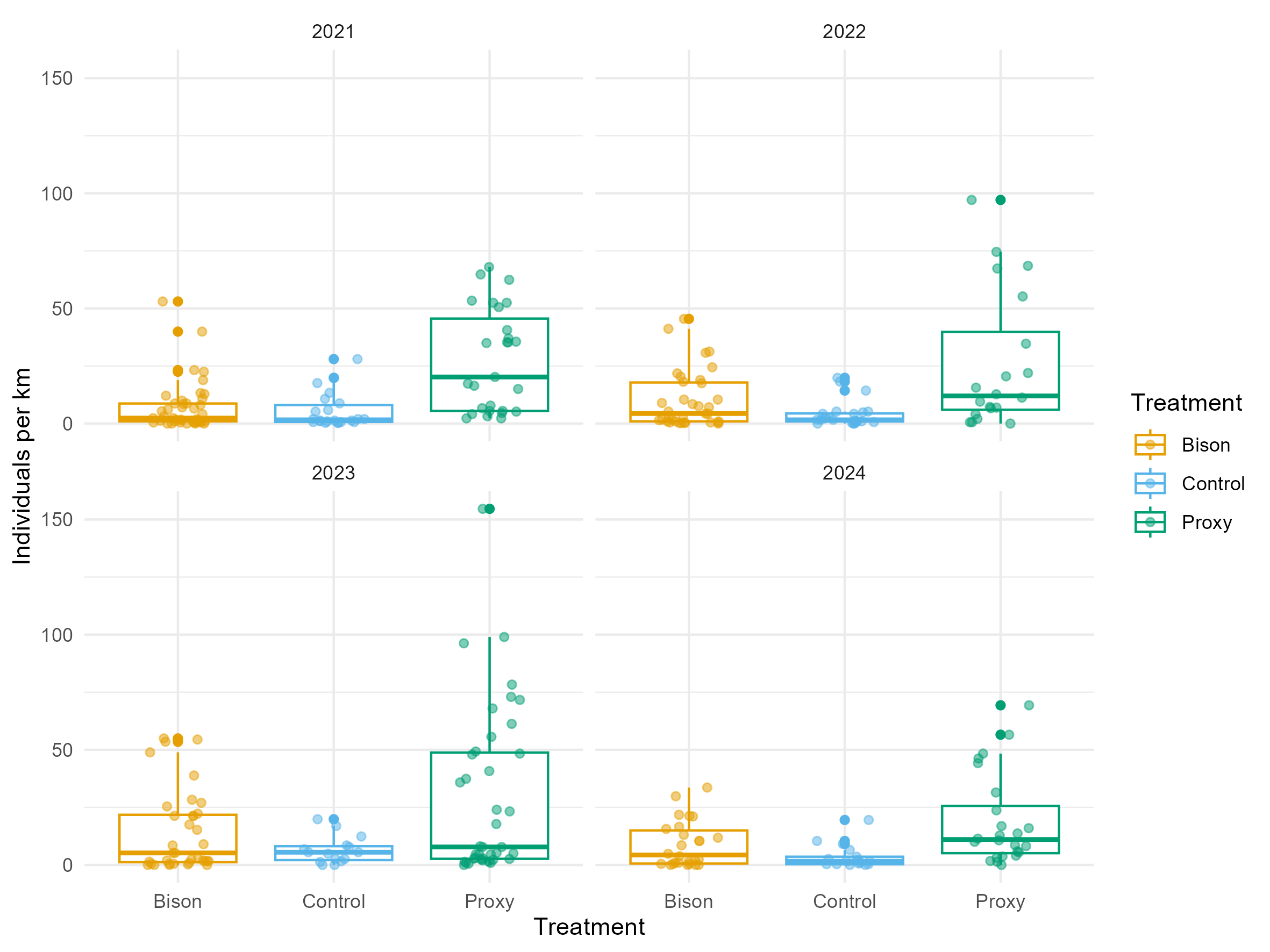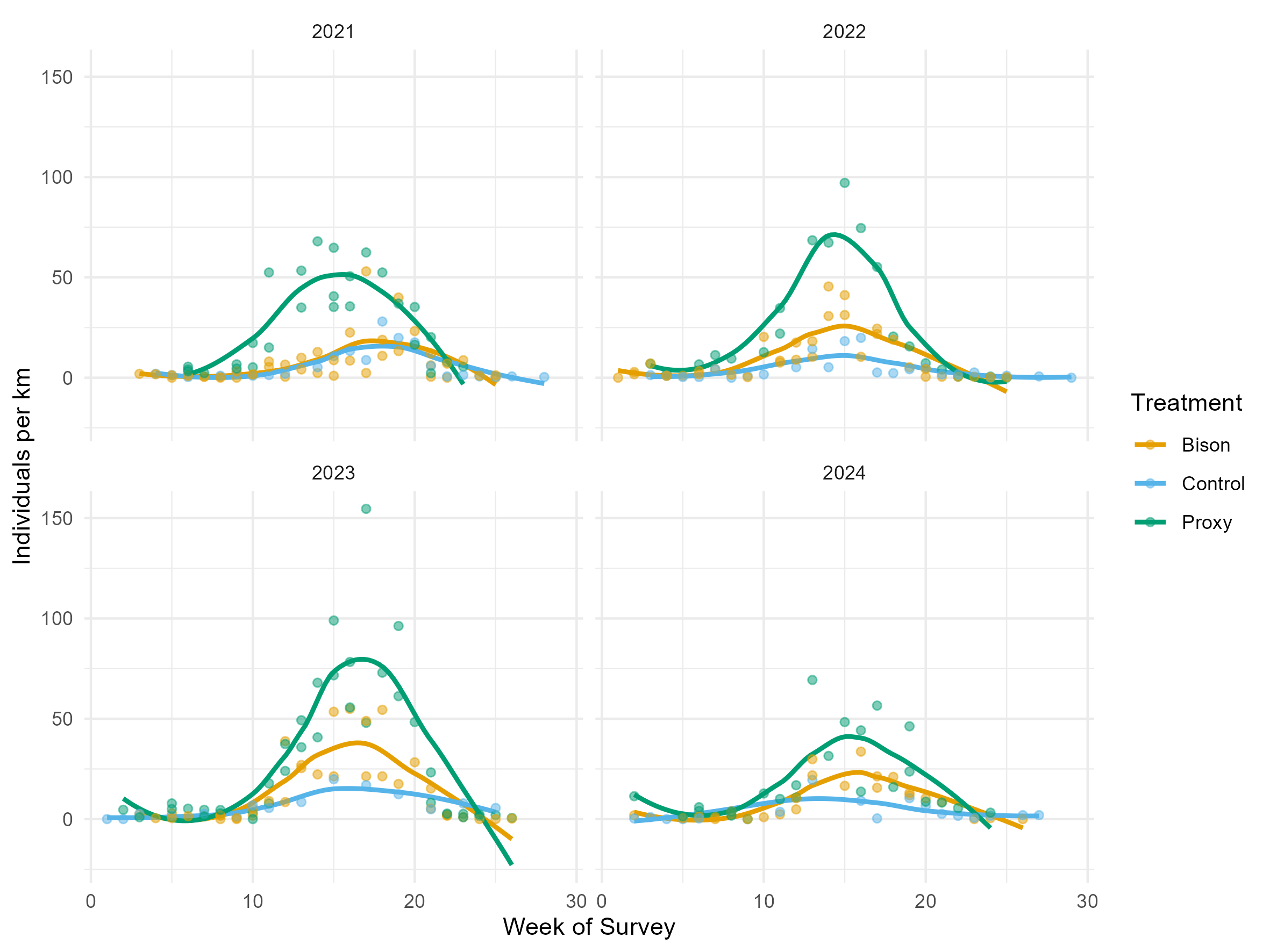Background
Wilder Blean is a wilding project at West Blean and Thornden Woods, near Canterbury, Kent, UK. The surrounding Blean woodland complex is one of the largest surviving blocks of ancient semi-natural woodland in England (Forestry Commission, 1998). Wilder Blean currently covers an area of 561.8 hectares, comprising a mosaic of ancient oak-hornbeam woodland, mixed broad-leaved coppice with standards, extensive stands of sweet chestnut coppice, conifer plantations, and small areas of heath and wetland as well as several man-made ponds.
Large grazing herbivores, including European bison Bison bonasus, Exmoor ponies Equus ferus caballus, British longhorn cattle Bos primigenius, and Iron Age pigs Sus scrofa × Sus domesticus, were introduced at Wilder Blean in 2022. This is a trial with the aim of improving the condition of the nationally important Site of Special Scientific Interest, some of which is in unfavourable condition (Natural England, 2025).
Large grazing herbivores went extinct in the UK, and across much of Europe, during the late Holocene at the end of the last Ice Age due to a combination of human activity and environmental changes. This was detrimental to the ecosystems in which they evolved, as the functions they provided were lost and natural processes they facilitated were disrupted. Large herbivores control plant growth, maintaining habitat mosaics which support more species, and they disperse seeds that they consume. They create microhabitats by disturbing the ground through trampling, dust bathing or wallowing. They recycle nutrients from plants back into the soils through their dung. They are prey for large predators and scavengers, and support birds and invertebrates that use them as hosts, their dung for food, or their fur for nesting materials. They sequester carbon into soils by depositing their dung and encouraging new rapid plant growth (Borer and Risch, 2024).
At Wilder Blean, the large herbivores have been reintroduced, but their dispersal is limited by fences. Fencing was required by law under the Dangerous Wild Animals Act 1976, which mandates secure containment for species classified as dangerous to the public. The fences separate the bison from public footpaths and bridleways. The fences are arranged to provide a robust experimental design, comprising three different treatments. The bison treatment area contains European bison. The proxy, or conservation grazers treatment area, contains British longhorn battle, Exmoor ponies and Iron Age pigs. The control treatment area contains no introduced grazing animals and is managed by a human workforce, including coppicing, for example. Due to the delayed construction of the bison tunnels, which allow the animals to travel under public rights of way and disperse across the site, the bison treatment has been limited to only one of five parcels in the southeast of the site.
This design enables a comparison of the effects of European bison, livestock commonly used for conservation purposes, and traditional human management on the ecosystem, to generate evidence on the effectiveness of European bison as a conservation management tool.
This report summarises the results of the UK Butterfly Monitoring Scheme surveys conducted between 2021 and 2024.
Methodology
Fieldwork
Butterfly abundance and diversity were monitored using standardized UK Butterfly Monitoring Scheme (UKBMS) transects. Each transect consisted of a fixed route, typically 1–2 km in length, walked weekly during the flight season (April to September) under suitable weather conditions (dry, low wind, and temperatures above 13°C). Observers recorded all butterflies seen within a 5-meter-wide corridor along the transect route. To account for variation in transect length, counts were adjusted per kilometre or accompanied by transect length as an offset term in statistical models. Transects were repeated annually, and observers followed consistent protocols to ensure comparability across years and sites. Data were entered into the UKBMS database.
Analysis
Total abundance
A generalized linear model with a negative binomial distribution (GLMNB) was used to investigate the effects of treatment type, calendar week, and year on butterfly total abundance. This distribution was chosen to appropriately handle the overdispersed nature of the count data. To account for variable sampling effort, transect length was included in the model as a logarithmic offset. Post-hoc pairwise comparisons were conducted using estimated marginal means to determine significant differences between the treatment types, with p-values adjusted for multiple comparisons using the Tukey method.
Additionally, post-hoc pairwise comparisons were conducted using estimated marginal means to compare between years within each treatment, to detect any before-after effect of bison on butterfly abundance.
Simpson's diversity index
A linear mixed-effects model (LMER) was used to investigate the effects of treatment type, calendar week, and year on butterfly species diversity, as measured by the Simpson's Diversity Index. The interaction between treatment and week was also included in the model. A random intercept for transect was included to account for the non-independence of repeated measures taken at the same transects over time. Post-hoc pairwise comparisons were conducted using estimated marginal means to determine significant differences between the treatment types, with p-values adjusted for multiple comparisons using the Tukey method.
Additionally, post-hoc pairwise comparisons were conducted using estimated marginal means to compare between years within each treatment, to detect any before-after effect of bison on butterfly abundance.
NMDS
A two-dimensional non-metric multidimensional scaling (NMDS) ordination was performed on the butterfly community data using Bray-Curtis dissimilarity.
Results
Total abundance
Butterfly abundance varied significantly among treatments and across weeks of the season. The model indicated a positive seasonal trend, with counts increasing by approximately 6.6% per week (β = 0.066, p < 0.001). Abundance in the proxy treatment was more than 4.7 times higher than in the control (β = 1.55, p < 0.001), while the bison treatment did not differ significantly from the control treatment overall (β = 0.01, p = 0.98; ≈ 1% higher). However, a significant interaction was detected between treatment and week for the bison treatment (β = 0.051, p = 0.041), which suggests that butterfly abundance in the bison areas increased more steeply across the season, at an additional 5.2% per week relative to the control treatment. Post-hoc comparisons of estimated marginal means confirmed clear differences between all treatments. Butterfly abundance was on average 52% lower in the control treatment than in the bison treatment (p = 0.0001), 82% lower in control than proxy (p < 0.0001), and 62% lower in bison than proxy (p < 0.0001). Year effects were weak, with a marginally significant increase in 2023 (β = 0.37, p = 0.050) which was 44% higher than 2021 but no significant differences in other years. Overall, these results show that the proxy treatment consistently supported the highest butterfly abundance, while the bison treatment showed a distinctive pattern of accelerating abundance through the season.
Whilst 2023 was the year with the highest numbers of butterflies recorded, the results did not show a statistically significant increase in butterfly numbers from transects in the bison treatment before bison were released in 2022, compared to after bison were released in 2023.
Simpson diversity
The model revealed no statistically significant interaction between treatment and week, indicating that the rate of change in butterfly diversity over the season did not differ significantly across the three treatment types. Furthermore, there was no significant main effect or post-hoc pairwise comparison of treatment on Simpson's Diversity Index. The main effect of week was marginally significant (t=−1.679, p=0.094), suggesting a slight decline in diversity as the season progressed. No significant main effect was found for year. The random effect of transect explained a small portion of the total variance, with a standard deviation of 0.055 compared to a residual standard deviation of 0.269.
In summary, this analysis found no evidence that butterfly species diversity was significantly affected by treatment type, calendar week, or year during the study period. This contrasts with the abundance results, indicating species diversity does not change in relation to total butterfly numbers.
The results did not show a statistically significant increase in butterfly diversity from transects in the bison treatment before bison were released in 2022, compared to after bison were released in 2023.
Non-metric Multidimensional Scaling (NMDS)
The ordination shows the overall butterfly community composition across the four-year study period, with a separate panel for each year. Each point represents a single survey, and the ellipses enclose the points for each of the three treatment types. The statistically significant species are shown in the ordination space.
The final solution had a stress value of 0.191, which is generally considered an acceptable fit, indicating that the two-dimensional plot is a reasonably faithful representation of the underlying community dissimilarities.
The ordination has extensive overlap of the ellipses for the three treatments across all four years. The high degree of overlap suggests that the butterfly community composition is broadly similar among all treatments, with no clear visual evidence of a distinct community in any one group. The significant species that are driving the ordination space are all situated toward the centre of the ordination, indicating their presence across most sites and treatments. There is no directional shift in the community composition of any of the treatment groups across the four years. The community structure appears to remain relatively stable and consistent. In conclusion, the NMDS results indicate that the different management treatments have so far not led to a clear, detectable change in the overall butterfly community composition during the four-year study period.
Discussion
The study found significant differences in butterfly abundance among the different treatment types. The proxy treatment, which utilized British longhorn cattle, Exmoor ponies, and Iron Age pigs, consistently supported the highest butterfly abundance, which was more than 4.7 times higher than in the control area. This suggests that the presence of these conservation grazers is highly effective at maintaining and/or increasing the total number of butterflies in a given area. Large herbivores are known to benefit ecosystems by creating and maintaining habitat mosaics, which support a greater variety of species.
While the bison treatment did not differ significantly from the control area in overall abundance, a notable interaction was found between the bison treatment and the time of year. Butterfly abundance in the bison area showed a more pronounced increase over the course of the season, growing at an additional 5.2% per week compared to the control. This distinctive pattern of accelerating abundance through the season suggests a potential long-term benefit of bison grazing on butterfly populations, something we will continue to monitor in the future.
Despite the observed trends, the results did not show a statistically significant increase in butterfly numbers in the bison treatment area when comparing the period before the bison's release in 2022 to the period after in 2023. This could be due to the short time since the introduction of the bison and the limited area of the soft release they occupied for some time.
In contrast to the findings on abundance, the analysis found no evidence that butterfly species diversity, as measured by the Simpson's Diversity Index, was significantly affected by the treatment type, calendar week, or year. The study did not detect a statistically significant increase in diversity in the bison treatment area after the bison's release. This result indicates that while the total number of butterflies increased in some treatments, the variety of species did not change significantly over the four years.
The NMDS further supported the findings on diversity, showing that the overall butterfly community composition was broadly similar across all three treatments. The ordination revealed extensive overlap of the treatment groups, indicating that no single management strategy, has so far, led to a distinct butterfly community. The lack of change in community composition and diversity, despite the changes in abundance, suggests that the initial effects of grazing are primarily on the population size of locally common species, rather than on the establishment of new, or the decline of existing, species.
Further monitoring is required to understand the long-term effects of conservation grazers and bison on butterfly populations and to determine if the changes in habitat caused by the large herbivores will eventually lead to an increase in species diversity and a shift in community composition.
References
Borer E & Risch A (2024). Planning for the future: Grasslands, herbivores, and nature‐based solutions. Journal of Ecology. DOI: 10.1111/1365-2745.14323.
Forestry Commission / Forest Research. (1998). National Inventory of Woodland & Trees – Great Britain. Forest Research. Retrieved from https://cdn.forestresearch.gov.uk/2022/02/nigreatbritain.pdf
Natural England (accessed May 2025). West Blean and Thornden Woods SSSI. https://designatedsites.naturalengland.org.uk/SiteDetail.aspx?SiteCode=S1003346





